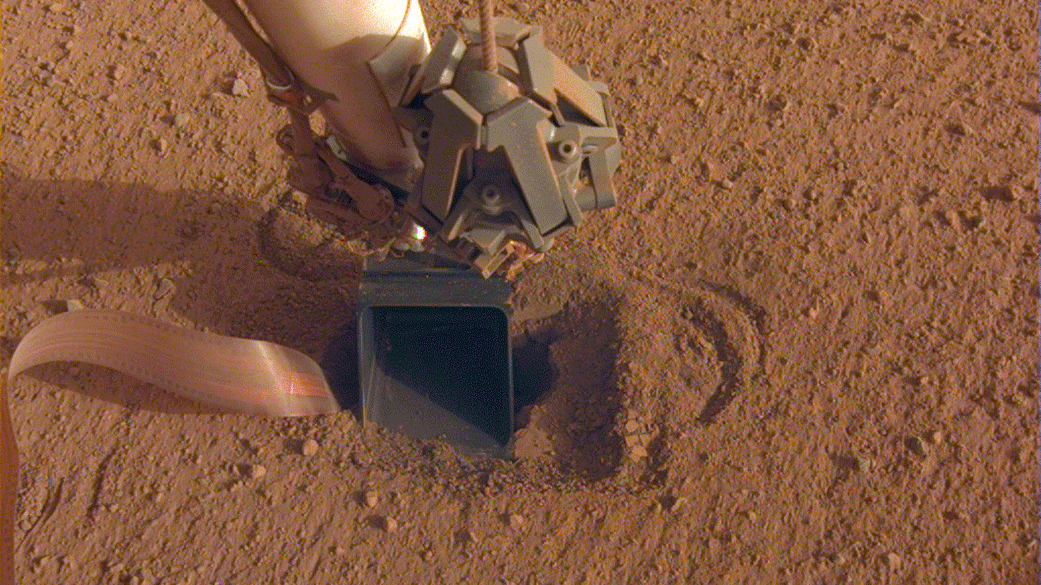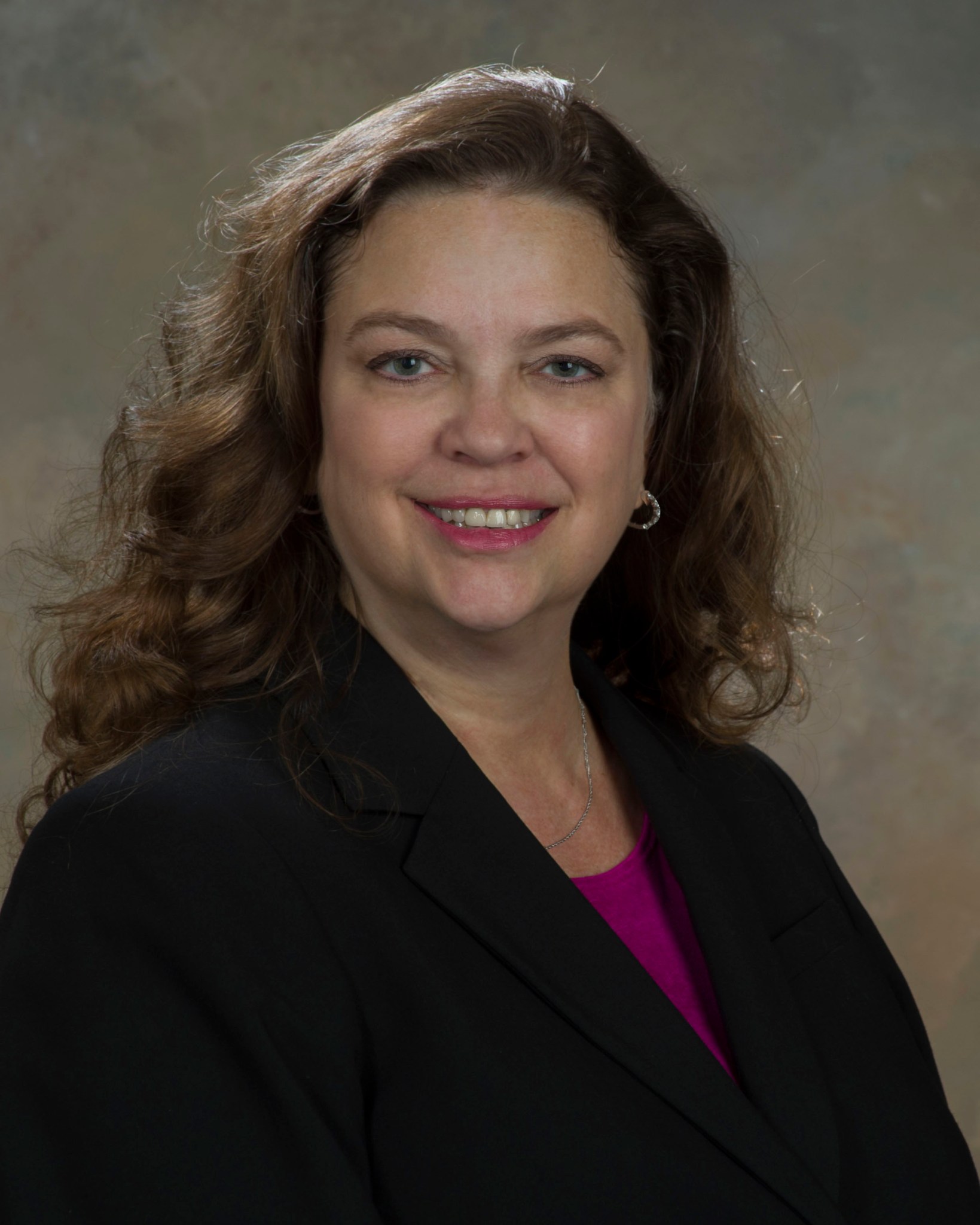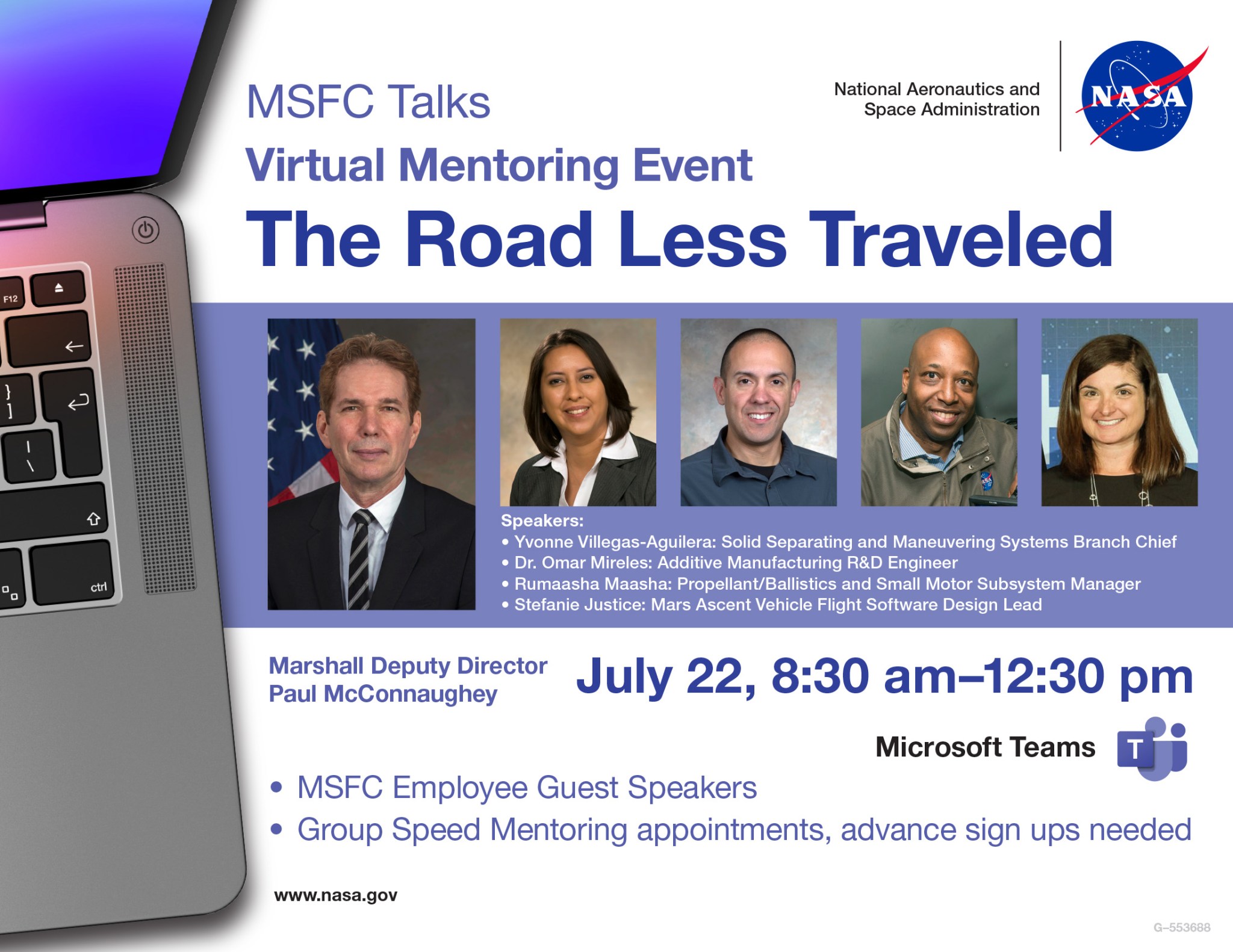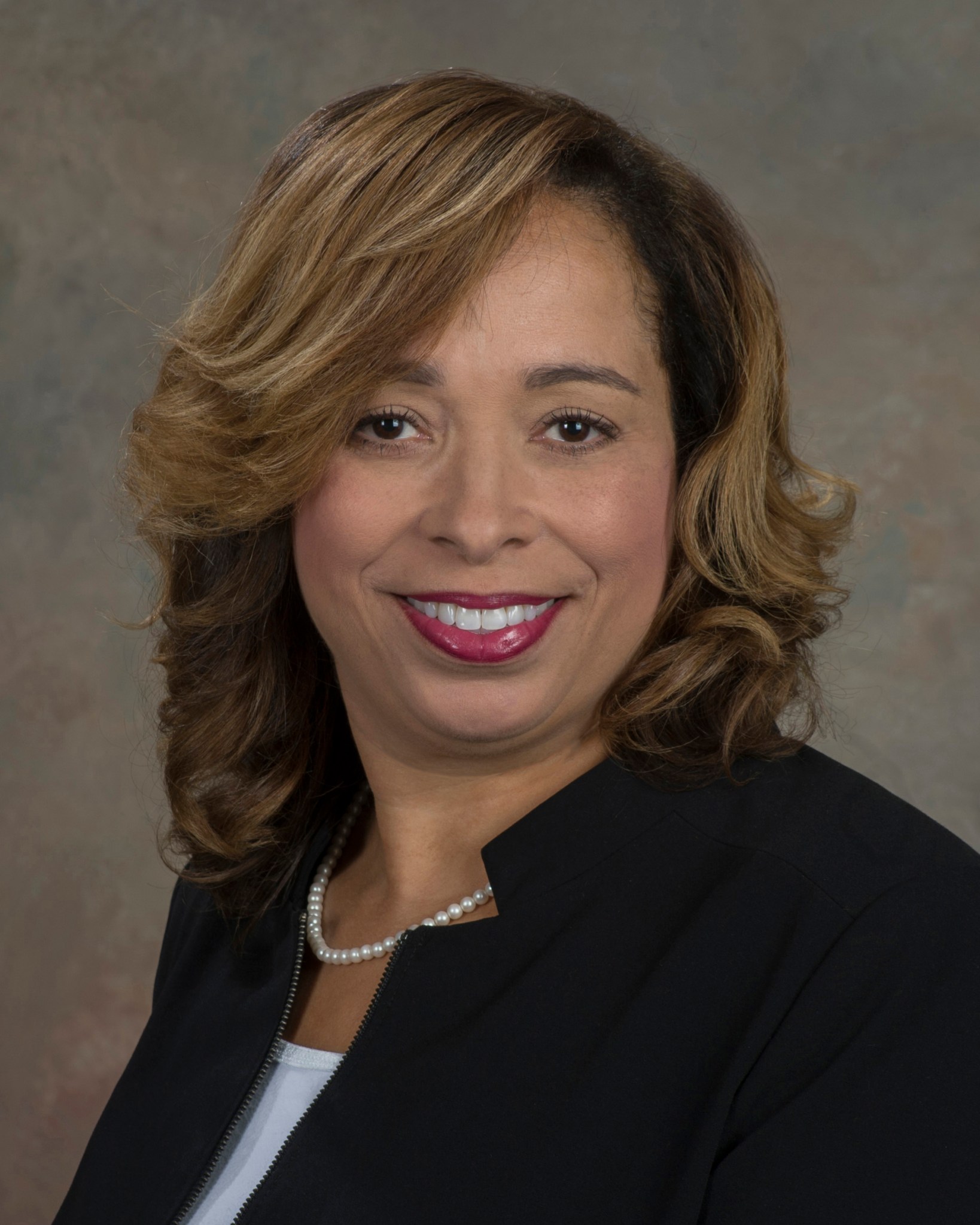In This Week’s Star
- NASA’s InSight Lander Flexes Arm While Burrowing ‘Mole’ Hits Pause
- Marshall Prepares Artemis I Rocket Hardware for Kennedy
- The Faces of NASA’s Artemis Gateway: Ginger Flores
- Five Marshall Team Members Honored as a HEO HErO
- Marshall’s ‘Road Less Traveled’ Mentoring Event Set for July 22
- Retired NASA Astronaut Jim Wetherbee to Deliver Mission Success is in Our Hands Lecture
- Artemis Innovation Management Solutions President to Give Virtual Tech Talk
- NASA’s Psyche Mission Reaches Milestone, Highlighted on ‘This Week @NASA’
- This Week in NASA History: STS-104 Launches to Space Station – July 12, 2001
- Michoud Deputy Director Roslin Hicks Dies
NASA’s InSight Lander Flexes Arm While Burrowing ‘Mole’ Hits Pause
NASA’s InSight lander is providing the first real look at the Red Planet’s deep interior, revealing details about the formation of Mars and, ultimately, that of all rocky planets, including Earth.
InSight uses a robotic arm to help its heat probe known as the “mole” burrow into the Martian surface. Akin to a 16-inch-long pile driver, the self-hammering mole had experienced difficulty digging into the Martian soil since it began work in February 2019. It is mostly buried now, thanks to recent efforts to push down on the mole with the scoop on the end of the robotic arm. But whether it will be able to dig deep enough – at least 10 feet – to get an accurate temperature reading of the planet remains to be seen.
Images captured by InSight of a June 20 hammering session show bits of soil jostling inside the scoop, suggesting that the mole may be bouncing in place and knocking the bottom of the scoop, which is blocking the mole from withdrawing. The team plans to move the arm aside to better assess how the soil and mole are interacting.
InSight, which landed on Mars in November 2018, is part of the agency’s Discovery Program, managed by NASA’s Marshall Space Flight Center. Heidi Haviland, an InSight science team member and researcher in Marshall’s Heliophysics and Planetary Science Branch, said such minor obstacles are expected when conducting science a world away.
“There are always surprises,” she said. “That’s part of the challenge and intrigue of planetary missions. We won’t give up until the mole is operational again.”
The mole is part of the Heat Flow and Physical Properties Package, provided for NASA by the German Aerospace Center in Cologne. Read more about the instrument on the blog by HP3 principal investigator Tilman Spohn of the German Aerospace Center.
While the campaign to save the mole continues, the arm will be used to pursue other science and engineering work in the months ahead. Mission researchers plan to use InSight’s arm camera to pan across the spacecraft’s solar panels – something they haven’t done since July 2019. Because it is the dusty season on Mars, the panels are likely coated with a fine layer of reddish-brown particles. Estimating how much dust has collected will help engineers better assess InSight’s daily power supply.
“Fully powering the spacecraft’s meteorological instruments is a priority,” Haviland said. “The dust and wind storms themselves would be fascinating to observe. The weather data we’re already gathering will help improve Martian global atmospheric circulation models and enable us to improve predictions for future human and rover mission planning.”
Strong winds and whirling dust devils previously helped clear the Curiosity and Opportunity rovers of accumulated dirt, Haviland said. She hopes InSight will benefit from a similar atmospheric helping hand.
Researchers also want to resume using the arm to spot meteors streaking across the night sky, as they did earlier in the mission. Doing so will complement data from InSight’s seismometer, the Seismic Experiment for Interior Structure, helping them to better predict how often meteors strike this part of Mars.
The seismometer detected its first marsquake nearly three months after starting its measurements in January 2019. By that fall, it was detecting a potential quake or two per day. While the instrument has detected more than 480 seismic signals overall, the rate has dropped to less than one per week, a rate change researchers attribute to seasonal variations of atmospheric turbulence, which creates noise that covers up tiny quake signals. Despite its protective shield, the seismometer is sensitive enough that wind vibration can make quakes harder to isolate.
JPL manages InSight for NASA’s Science Mission Directorate. Lockheed Martin Space in Denver built the spacecraft, including its cruise stage and lander, and supports spacecraft operations for the mission. European partners include France’s Centre National d’Études Spatiales and the German Aerospace Center. Significant contributors include Institut de Physique du Globe de Paris; the Max Planck Institute in Germany; the Swiss Federal Institute of Technology in Switzerland; the Space Research Center of the Polish Academy of Sciences and Astronika in Poland; Centro de Astrobiología in Spain; and Imperial College London and Oxford University in the United Kingdom.
Marshall Prepares Artemis I Rocket Hardware for Kennedy
Teams at NASA’s Marshall Space Flight Center are preparing to ship a key piece of hardware to NASA’s Kennedy Space Center in preparation for the first Artemis launch to the Moon. The launch vehicle stage adapter connects the upper stage and core stage of the agency’s Space Launch System rocket. While the larger stages of the SLS rocket are manufactured at other NASA facilities, the launch vehicle stage adapter flight hardware is produced exclusively at Marshall by Teledyne Brown Engineering of Huntsville. For more information about SLS, visit here.
The Faces of NASA’s Artemis Gateway: Ginger Flores
NASA’s Artemis program, set to land the first woman and next man on the lunar surface by 2024, also will establish an unprecedented, sustainable presence around the Moon with Gateway, an orbital staging point for lunar excursions and deep space exploration missions to come.
Among the men and women who make up Gateway’s diverse and dedicated development team is Ginger Flores, manager of the Habitation Systems Development Office at NASA’s Marshall Space Flight Center.
Flores, a Huntsville native, was born in 1969 – the same year Neil Armstrong and Buzz Aldrin became the first human beings to walk on the Moon – so she doesn’t dismiss the idea that her NASA career was predestined. “Growing up in Rocket City, I was surrounded by symbols of NASA,” she said. “Working at NASA became my dream job since I was a small child.”
While attending the University of Alabama in Huntsville, one of Flores’ professors reinforced her childhood passion during his classes when he used real-life examples from his day job – supporting the International Space Station. Flores earned her bachelor’s and master’s degrees from UAH in industrial and systems engineering in 1993 and 1998, respectively.
She began her NASA career in 2002 at Marshall, where she managed several innovative projects that helped astronauts work and perform research in a confined space while in orbit.
“Solving problems that made work easier for astronauts was an experience that really cemented my desire to work for NASA,” she said.
Flores now oversees development of concepts and design solutions for Gateway habitation systems, integrating plans for where the crew will live, work, and spend their free time while they pursue long-duration stays on the lunar surface – and eventually embark for new missions of discovery on Mars.
“I’m proud to be an early member of the Gateway Program, which crosses many centers at the agency and brings folks together with a diverse set of experiences and backgrounds,” she said.
Her love for all things space and NASA extends to her personal life. She enjoys underwater exploration, which she says brings her closest to the sensation of being an astronaut. “There is a sense of peace and rejuvenation that comes with diving that is hard to duplicate,” she said.
Flores is married to Anthony Flores, her high school sweetheart, and is an animal lover who makes a home for rescued senior dogs, including a recent addition that rode out the Nashville tornadoes of 2020 under an interstate highway bridge.
Read more about Flores’s NASA career here, and find the ongoing feature series about Artemis Gateway team members here.
Five Marshall Team Members Honored as a HEO HErO

From left, Kevin McCarley, Amy Buck, Kiera Spann, and Heather Hall, along with Gregg Eldridge, not pictured, are the latest team members from NASA’s Marshall Space Flight Center and Michoud Assembly Facility to be named a HEO HErO. McCarley used his systems engineering experience and knowledge to help establish the overall capability and process for providing secondary payloads on the Space Launch System. Buck presented her version of the Thermal Protection Systems 101 training class to personnel who support the SLS Stages Material Review Board. Spann is an integral member of the SLS Booster procurement team who leads the new SLS Booster Production and Operations Contract effort for SLS flight sets 4-9. Hall helped establish the Human Landing System Program Office by defining policies and procedures. Eldridge took the initiative to keep personnel engaged with critical mission support work and set up a series of talks with subject matter experts relevant to Stages and the Michoud production processes and topics. Each week, the Human Exploration and Operations Mission Directorate recognizes HEO HErOes, team members from across the agency who have made vital contributions in their support of NASA’s mission to land the first woman and next man on the Moon by 2024. (NASA)
Marshall’s ‘Road Less Traveled’ Mentoring Event Set for July 22
By Kristen Conner Hill
NASA’s Marshall Space Flight Center Deputy Director Paul McConnaughey will lead the center’s summer virtual mentoring event, “The Road Less Traveled,” from 8:30 a.m.-12:30 p.m. on July 22 via Microsoft Teams. It is open to all, but specifically geared toward interns and young professionals.
“Everyone’s journey is different, and there are many avenues to get where you’d like to go in your career,” McConnaughey said. “Mentorship is important along all parts of the path. This event is all about showing young professionals, and those just starting their careers, that it’s OK if you don’t have it all figured out yet and that life may take some twists and turns to take you where you’re meant to be within NASA. Our mentors will share their experiences and be a lantern for those who are looking to take their first steps on that road.”
Four speakers from Marshall will each lead a group session to share their stories, take questions, and give advice. Scheduled speakers are: Yvonne Villegas-Aguilera, Solid Separating and Maneuvering Systems branch chief; Omar Mireles, Additive Manufacturing research and development engineer; Rumaasha Maasha, Propellant/Ballistics and Small Motor Subsystem manager in the Booster Element Office; and Stefanie Justice, Mars Ascent Vehicle Flight Software Design lead.
Speed mentoring opportunities will be available with Rae Ann Meyer, deputy manager of the Science and Technology Office; Lisa Watson-Morgan, manager of the Human Landing System Program; Lien Moore, lead for Integrated Avionics & Software; Tawnya Laughinghouse, manager of the Technology Demonstrations Missions Program; Cindy Stemple, deputy Chief Financial Officer; Latonya Powell, office chief in Business Enabling Applications; Wes Brown, manager of the Office of Strategy; Eric Melkerson, manager of the Project Engineering Branch; Mike Fazah, deputy director of the Propulsion Systems Department; Renee Weber, Marshall chief scientist; Mark Cooper, director of the Materials and Processes Laboratory; and Allyson Thomas, lead for the Spacecraft & Payload Integration Deputy Adapter.
To register, visit here.
Hill, an LSINC employee, supports Marshall’s Office of Strategic Analysis & Communications.
Retired NASA Astronaut Jim Wetherbee to Deliver Mission Success is in Our Hands Lecture
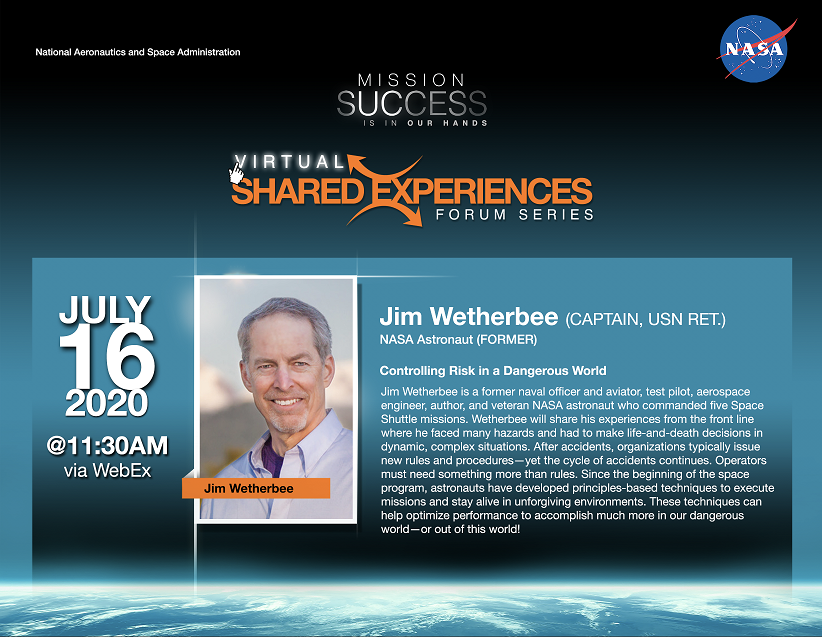
Jim Wetherbee, retired NASA astronaut and naval test pilot, will deliver a virtual Mission Success is in Our Hands lecture via WebEx at 11:30 a.m. July 16. Wetherbee will share his experiences from the frontlines, having commanded five space shuttle missions and helped advance naval aviation. He will discuss principle-based techniques designed to execute missions and keep astronauts safe in the most unforgiving environments. The Mission Success Is in Our Hands initiative at NASA’s Marshall Space Flight Center is a campaign led by the center’s Safety and Mission Assurance Directorate and partner Jacobs Engineering of Huntsville that promotes and strengthens Marshall’s focus on mission, hardware, and crew safety. (NASA)
Artemis Innovation Management Solutions President to Give Virtual Tech Talk
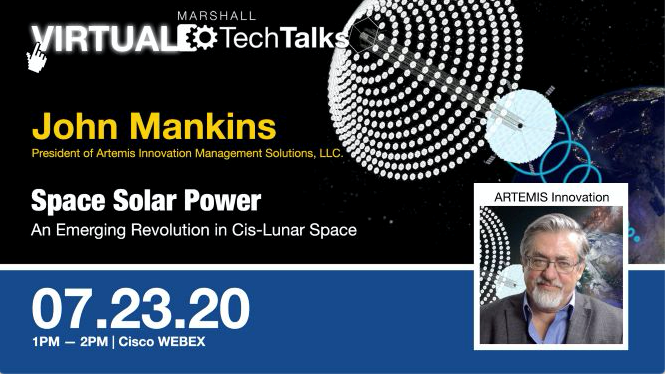
John Mankins, president of Artemis Innovation Management Solutions in Santa Maria, California, will be the featured speaker at NASA’s Marshall Space Flight Center’s Tech Talk series, held virtually at 1 p.m. July 23. Mankins will review past and present activities and future directions for solar power in space. He will also discuss technologies and systems concepts for space solar power and wireless power transmission, and associated emerging technologies and markets. Mankins has worked for 25 years at the agency’s Jet Propulsion Lab in Southern California. The talk will be streamed via WebEx; login information can be found here. The Tech Talk series is presented by the Marshall Center Chief Technologist’s Office. (NASA)
NASA’s Psyche Mission Reaches Milestone, Highlighted on ‘This Week @NASA’
NASA’s Psyche mission is featured in “This Week @NASA,” a weekly video program broadcast on NASA-TV and posted online.
The Psyche mission to explore a metal-rich asteroid – also named Psyche — recently passed a crucial mission milestone. The systems designed to work in deep space are now ready to be built. Psyche is set to launch in August 2022 and will fly to its target in the main asteroid belt between Mars and Jupiter.
Mission scientists and engineers worked together to plan the investigations that will determine what makes up the asteroid Psyche, one of the most intriguing targets in the main asteroid belt. Scientists think that, unlike most other asteroids that have rocky or icy bodies, Psyche is largely made of metallic iron and nickel – similar to Earth’s core – and could be the heart of an early planet that lost its outer layers.
Psyche is a project of the Science Mission Directorate’s Discovery Program, managed by NASA’s Marshall Space Flight Center.
View this and previous episodes at “This Week @NASA” on NASA’s YouTube page.
This Week in NASA History: STS-104 Launches to Space Station – July 12, 2001
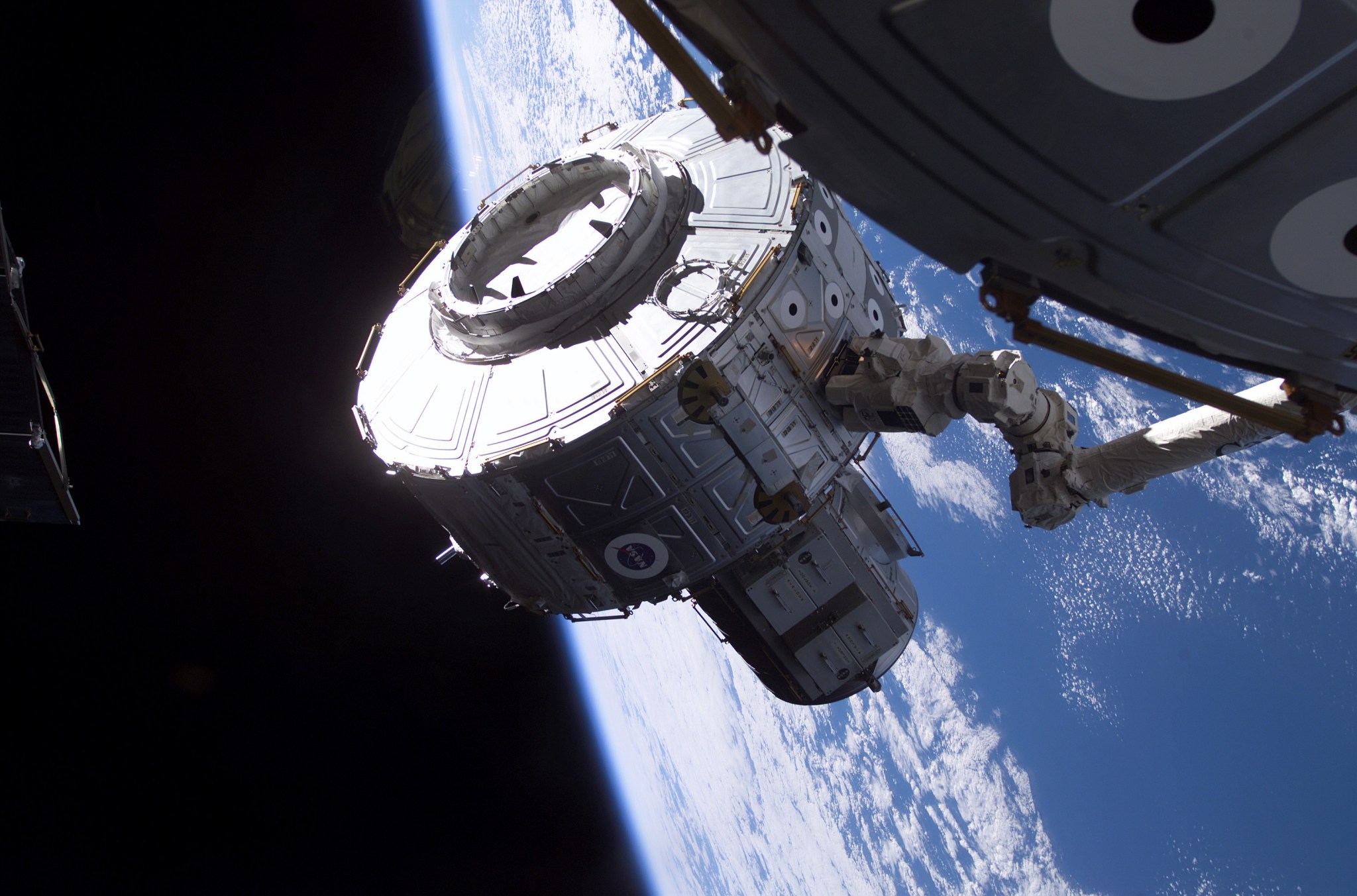
This week in 2001, space shuttle Atlantis, mission STS-104, launched from NASA’s Kennedy Space Center on a 12-day mission to the International Space Station. In a series of three spacewalks, astronauts attached the Quest joint airlock module to the Unity node and affixed high-pressure gas tanks to the airlock. The space station and shuttle crews also tested nitrogen and oxygen lines for use on future shuttle missions and installed valves to connect Quest to the station’s environmental control system. Here, the Quest airlock is installed onto the starboard side of the Unity node. Today, the Payload Operations Integration Center at NASA’s Marshall Space Flight Center serves as “science central” for the International Space Station, working 24/7, 365 days a year in support of the orbiting laboratory’s science experiments. The NASA History Program is responsible for generating, disseminating, and preserving NASA’s remarkable history and providing a comprehensive understanding of the institutional, cultural, social, political, economic, technological, and scientific aspects of NASA’s activities in aeronautics and space. For more pictures like this one and to connect to NASA’s history, visit the Marshall History Program’s webpage. (NASA)
Michoud Deputy Director Roslin Hicks Dies
Roslin Hicks, 54, the first female deputy director of NASA’s Michoud Assembly Facility, died June 30.
Hicks had served as Michoud’s deputy director since June 2017, appointed to the role for a year as acting before taking over the office permanently. Prior to her time at Michoud, she spent 30 years at NASA’s Marshall Space Flight Center, where her roles included supervisor of the Planning and Facilities Utilization Office from 2008-17; the center’s project manager for implementation of Homeland Security Presidential Directive 12 from 2006-08; and special assistant to former Marshall Director Art Stephenson from 2001-02.
“Roslin was a great friend and team member for Marshall and Michoud, and a strong advocate for women in her field,” Marshall Director Jody Singer said. “It hurts saying goodbye to her, but I am comforted by the fact that Roslin was a role model for many who will carry on the lessons she left with us. I appreciate her dedicated service to our mission and will miss her very much. Her leadership has been instrumental in overseeing the progress we are making today.”
Hicks began her NASA career in 1987 as a cooperative education student in Marshall’s Avionics Laboratory, testing batteries for the Hubble Space Telescope, before joining Marshall full-time in 1990.
Hicks received numerous awards during her NASA career, including the Center Director’s Commendation, NASA Certificate of Appreciation, NASA Group Achievement Award, NASA Special Service Award, Sustained Superior Performance Awards, Group Achievement awards, Special Service awards, NASA Exceptional Achievement Medal, and the Federal Women’s Program Outstanding Supervisor Award.
Hicks earned a bachelor’s degree in mechanical engineering from North Carolina Agricultural and Technical State University in Greensboro.
She is survived by her husband, Gregory, two adult children, Bayleigh and Brandon, and her mother, Joyce Maddox.




























